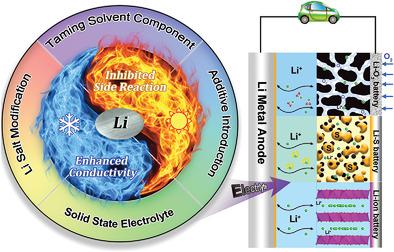Our official English website, www.x-mol.net, welcomes your
feedback! (Note: you will need to create a separate account there.)
Electrolyte Design for Lithium Metal Anode-Based Batteries Toward Extreme Temperature Application
Advanced Science ( IF 14.3 ) Pub Date : 2021-07-17 , DOI: 10.1002/advs.202101051 Dan Luo 1, 2 , Matthew Li 2 , Yun Zheng 2 , Qianyi Ma 2 , Rui Gao 2 , Zhen Zhang 2 , Haozhen Dou 2 , Guobin Wen 1, 2 , Lingling Shui 1 , Aiping Yu 2 , Xin Wang 1 , Zhongwei Chen 2
Advanced Science ( IF 14.3 ) Pub Date : 2021-07-17 , DOI: 10.1002/advs.202101051 Dan Luo 1, 2 , Matthew Li 2 , Yun Zheng 2 , Qianyi Ma 2 , Rui Gao 2 , Zhen Zhang 2 , Haozhen Dou 2 , Guobin Wen 1, 2 , Lingling Shui 1 , Aiping Yu 2 , Xin Wang 1 , Zhongwei Chen 2
Affiliation

|
Lithium anode-based batteries (LBs) are highly demanded in society owing to the high theoretical capacity and low reduction potential of metallic lithium. They are expected to see increasing deployment in performance critical areas including electric vehicles, grid storage, space, and sea vehicle operations. Unfortunately, competitive performance cannot be achieved when LBs operating under extreme temperature conditions where the lithium-ion chemistry fail to perform optimally. In this review, a brief overview of the challenges in developing LBs for low temperature (<0 °C) and high temperature (>60 °C) operation are provided followed by electrolyte design strategies involving Li salt modification, solvation structure optimization, additive introduction, and solid-state electrolyte utilization for LBs are introduced. Specifically, the prospects of using lithium metal batteries (LMBs), lithium sulfur (Li-S) batteries, and lithium oxygen (Li-O2) batteries for performance under low and high temperature applications are evaluated. These three chemistries are presented as prototypical examples of how the conventional low temperature charge transfer resistances and high temperature side reactions can be overcome. This review also points out the research direction of extreme temperature electrolyte design toward practical applications.
中文翻译:

面向极端温度应用的锂金属负极电池的电解质设计
由于金属锂的高理论容量和低还原电位,锂阳极电池(LB)在社会上的需求量很大。预计它们将在电动汽车、电网存储、太空和海上车辆运营等性能关键领域得到越来越多的部署。不幸的是,当锂离子电池在锂离子化学性能无法发挥最佳性能的极端温度条件下运行时,就无法实现具有竞争力的性能。在这篇综述中,简要概述了开发低温(<0°C)和高温(>60°C)操作的LB所面临的挑战,随后介绍了涉及锂盐改性、溶剂化结构优化、添加剂引入的电解质设计策略,并介绍了LB的固态电解质利用。具体而言,评估了使用锂金属电池(LMB)、锂硫(Li-S)电池和锂氧(Li-O 2 )电池在低温和高温应用下的性能的前景。这三种化学物质作为典型示例展示了如何克服传统的低温电荷转移电阻和高温副反应。该综述还指出了极端温度电解液设计面向实际应用的研究方向。
更新日期:2021-09-22
中文翻译:

面向极端温度应用的锂金属负极电池的电解质设计
由于金属锂的高理论容量和低还原电位,锂阳极电池(LB)在社会上的需求量很大。预计它们将在电动汽车、电网存储、太空和海上车辆运营等性能关键领域得到越来越多的部署。不幸的是,当锂离子电池在锂离子化学性能无法发挥最佳性能的极端温度条件下运行时,就无法实现具有竞争力的性能。在这篇综述中,简要概述了开发低温(<0°C)和高温(>60°C)操作的LB所面临的挑战,随后介绍了涉及锂盐改性、溶剂化结构优化、添加剂引入的电解质设计策略,并介绍了LB的固态电解质利用。具体而言,评估了使用锂金属电池(LMB)、锂硫(Li-S)电池和锂氧(Li-O 2 )电池在低温和高温应用下的性能的前景。这三种化学物质作为典型示例展示了如何克服传统的低温电荷转移电阻和高温副反应。该综述还指出了极端温度电解液设计面向实际应用的研究方向。











































 京公网安备 11010802027423号
京公网安备 11010802027423号